Puget Systems and iBUYPOWER: two sides of the system integrator coin
by Jarred Walton on February 15, 2007 10:25 AM EST- Posted in
- Systems
iBUYPOWER: Construction and Design
We have two iBUYPOWER systems to look at, one priced at around $3000 and the other priced at closer to $1300. Not surprisingly, all of the components are completely different when comparing the two systems. The high-end system includes a quad core processor, X1950 XTX CrossFire graphics, an ASUS P5W DH 975X motherboard, 2GB Corsair Dominator memory, and three hard drives (two 150GB Raptors in RAID 0 and a 400GB Western Digital drive for mass storage), all packed into a Thermaltake Armor Jr. case. The midrange system uses an ASUS P5NSLI (nForce 570 SLI) motherboard, a single GeForce 7900 GS graphics card, two 160GB Hitachi drives, 2GB of Corsair XMS2 memory (CM2X1024-6400), with everything installed in an NZXT Apollo case. Both systems use NZXT power supplies, but the midrange system uses a 500W model while the high-end system uses a 650W model. Let's take a closer look at the midrange build first.
Midrange System
Opinions on what the case looks like are going to vary, and there are certainly people out there that think this style of case looks cool. Unfortunately, we're not among those people, but it's simple enough to get a case that you like by going through the configurator. The front panel has a plastic construction that is somewhat reminiscent of Alienware's cases, but it feels and looks pretty cheap. Moreover, the huge door that can be opened simply gets in the way whenever you need to use an optical drive or the flash memory reader. It's possible to remove the door, but you're much better off getting a case that doesn't have a door in the first place if that's what you intend to do.
The case itself is pretty lightweight, and the somewhat lower-end configuration means that all of the parts can fit into a smaller chassis. Of the three systems we're looking at today, this one is definitely the lightest and smallest, but the other two systems are quite large so that's not saying much. Other than the plastic front panel, the case is pretty decent, easily accommodating all of the hardware that's installed. The left side has a window allowing you to see the internals, and there's also a large 120mm fan set into the window that helps to cool the expansion card area. There's a second 120mm case fan at the rear of the system that serves as an exhaust.
The left side of the case is dominated by a window peering into the internals, while the right side is pretty much devoid of features other than the two USB ports, FireWire port, and headphone and microphone jacks. You may have noticed a problem when looking at the case window already, but let's pull the side off and take a closer look at the internals.
One of the problems with having a case window is that it allows you to see what the inside of the case looks like, and if the wiring isn't very clean that may not be a good thing. Unfortunately, the power supply cables on the system don't lend themselves very well to keeping a clean interior. iBUYPOWER has wrapped all the cables in zip-ties and tried to keep them out of the way, but the unsheathed cables are still something of an eyesore. Choosing a modular power supply might help, but unless the cables are going to be cleaned up significantly we would prefer to eliminate the case window. Some of the cables also don't appear to be quite long enough to reach their intended destinations easily, adding to the cable clutter -- the various cables leading towards the front panel for example could have used a bit more slack. If you're a neat freak when it comes to computer interiors, this type of system isn't going to keep you happy, but less-than-perfect cables certainly aren't the end of the world, especially in a midrange computer. We'll have to take a look at the high-end system to see if iBUYPOWER puts a bit more effort into keeping things clean on more expensive systems.
Besides the cables, and interior is as you would expect. There's plenty of room around the processor and memory, and the large 120mm fans should help keep things relatively cool. A third fan could be added at the front of the case, but it's not installed by default and really isn't necessary for most configurations. The drive bays use a plastic clamp and latch mechanism that makes swapping out components easier, but regular screws are used in many other locations. The expansion cards are secured with screws as well as black plastic clamps, which makes the clamps seem a bit superfluous.
Taking a look at the power supply, iBUYPOWER normally ships systems with a standard 420W PSU, so our test system has an upgraded 500W power supply. We never came anywhere near 500W (or even 400W for that matter) when measuring power draw, but given that we have an SLI capable motherboard it's conceivable that we might want to add a second graphics card in the future, in which case a larger PSU might not be a bad idea. NZXT PSUs are not generally considered to be among the best models available, however, so if you're going to spend the money to get something other than the default power supply it might be a good idea to spend more money to get better quality.
Overall, the midrange system offers a good value and it's reasonably well built, but it's not the most impressive system we've ever seen. A bit more time and care taken with system assembly could have helped matters, although some of our complaints still go back to the particular case that iBUYPOWER sent us. We left that decision up to them, but should you choose to have them build you a system this NZXT Apollo case definitely wouldn't rank high on our list of best overall choices. For that matter, most of the case offerings in the online configurator are pretty flashy, so people with more moderate tastes might have difficulty finding something they like. If you don't mind spending a bit more money, the Thermaltake Armor Jr. or Tuniq Symmetry look like decent alternatives. If you send iBUYPOWER an email or give them a call, they should be able to accommodate other case and component requests as well. Now let's see if anything changes when we move to the high-end configuration.
We have two iBUYPOWER systems to look at, one priced at around $3000 and the other priced at closer to $1300. Not surprisingly, all of the components are completely different when comparing the two systems. The high-end system includes a quad core processor, X1950 XTX CrossFire graphics, an ASUS P5W DH 975X motherboard, 2GB Corsair Dominator memory, and three hard drives (two 150GB Raptors in RAID 0 and a 400GB Western Digital drive for mass storage), all packed into a Thermaltake Armor Jr. case. The midrange system uses an ASUS P5NSLI (nForce 570 SLI) motherboard, a single GeForce 7900 GS graphics card, two 160GB Hitachi drives, 2GB of Corsair XMS2 memory (CM2X1024-6400), with everything installed in an NZXT Apollo case. Both systems use NZXT power supplies, but the midrange system uses a 500W model while the high-end system uses a 650W model. Let's take a closer look at the midrange build first.
Midrange System
Opinions on what the case looks like are going to vary, and there are certainly people out there that think this style of case looks cool. Unfortunately, we're not among those people, but it's simple enough to get a case that you like by going through the configurator. The front panel has a plastic construction that is somewhat reminiscent of Alienware's cases, but it feels and looks pretty cheap. Moreover, the huge door that can be opened simply gets in the way whenever you need to use an optical drive or the flash memory reader. It's possible to remove the door, but you're much better off getting a case that doesn't have a door in the first place if that's what you intend to do.
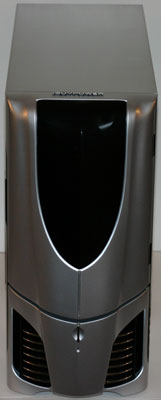 |
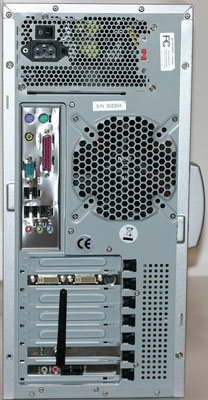 |
| Click to enlarge | |
The case itself is pretty lightweight, and the somewhat lower-end configuration means that all of the parts can fit into a smaller chassis. Of the three systems we're looking at today, this one is definitely the lightest and smallest, but the other two systems are quite large so that's not saying much. Other than the plastic front panel, the case is pretty decent, easily accommodating all of the hardware that's installed. The left side has a window allowing you to see the internals, and there's also a large 120mm fan set into the window that helps to cool the expansion card area. There's a second 120mm case fan at the rear of the system that serves as an exhaust.
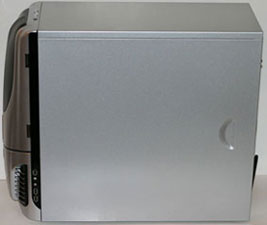 |
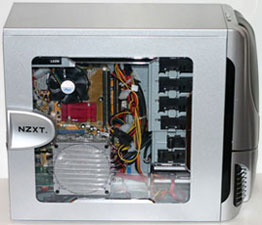 |
| Click to enlarge | |
The left side of the case is dominated by a window peering into the internals, while the right side is pretty much devoid of features other than the two USB ports, FireWire port, and headphone and microphone jacks. You may have noticed a problem when looking at the case window already, but let's pull the side off and take a closer look at the internals.
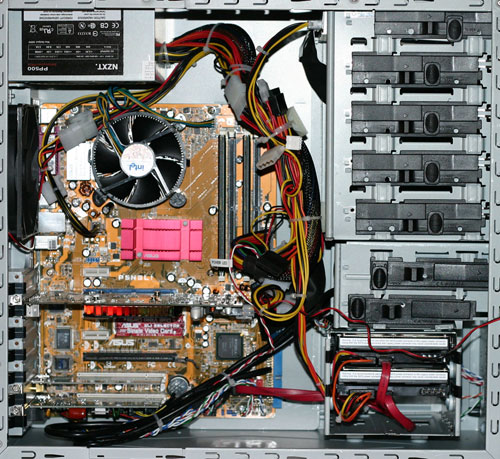 |
| Click to enlarge |
One of the problems with having a case window is that it allows you to see what the inside of the case looks like, and if the wiring isn't very clean that may not be a good thing. Unfortunately, the power supply cables on the system don't lend themselves very well to keeping a clean interior. iBUYPOWER has wrapped all the cables in zip-ties and tried to keep them out of the way, but the unsheathed cables are still something of an eyesore. Choosing a modular power supply might help, but unless the cables are going to be cleaned up significantly we would prefer to eliminate the case window. Some of the cables also don't appear to be quite long enough to reach their intended destinations easily, adding to the cable clutter -- the various cables leading towards the front panel for example could have used a bit more slack. If you're a neat freak when it comes to computer interiors, this type of system isn't going to keep you happy, but less-than-perfect cables certainly aren't the end of the world, especially in a midrange computer. We'll have to take a look at the high-end system to see if iBUYPOWER puts a bit more effort into keeping things clean on more expensive systems.
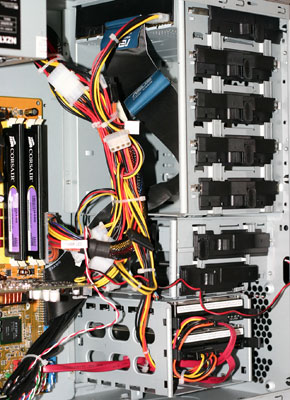 |
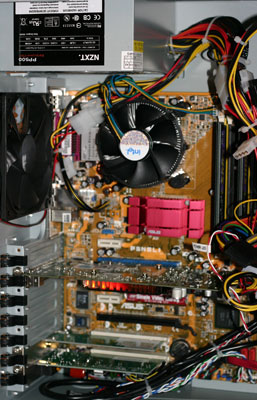 |
| Click to enlarge | |
Besides the cables, and interior is as you would expect. There's plenty of room around the processor and memory, and the large 120mm fans should help keep things relatively cool. A third fan could be added at the front of the case, but it's not installed by default and really isn't necessary for most configurations. The drive bays use a plastic clamp and latch mechanism that makes swapping out components easier, but regular screws are used in many other locations. The expansion cards are secured with screws as well as black plastic clamps, which makes the clamps seem a bit superfluous.
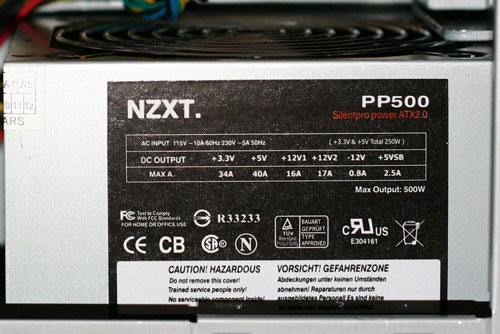 |
| Click to enlarge |
Taking a look at the power supply, iBUYPOWER normally ships systems with a standard 420W PSU, so our test system has an upgraded 500W power supply. We never came anywhere near 500W (or even 400W for that matter) when measuring power draw, but given that we have an SLI capable motherboard it's conceivable that we might want to add a second graphics card in the future, in which case a larger PSU might not be a bad idea. NZXT PSUs are not generally considered to be among the best models available, however, so if you're going to spend the money to get something other than the default power supply it might be a good idea to spend more money to get better quality.
Overall, the midrange system offers a good value and it's reasonably well built, but it's not the most impressive system we've ever seen. A bit more time and care taken with system assembly could have helped matters, although some of our complaints still go back to the particular case that iBUYPOWER sent us. We left that decision up to them, but should you choose to have them build you a system this NZXT Apollo case definitely wouldn't rank high on our list of best overall choices. For that matter, most of the case offerings in the online configurator are pretty flashy, so people with more moderate tastes might have difficulty finding something they like. If you don't mind spending a bit more money, the Thermaltake Armor Jr. or Tuniq Symmetry look like decent alternatives. If you send iBUYPOWER an email or give them a call, they should be able to accommodate other case and component requests as well. Now let's see if anything changes when we move to the high-end configuration.










17 Comments
View All Comments
EvErywhErE - Saturday, October 25, 2008 - link
Great Article on Pudget! I stumbled accross them quite by accident last month after my work machine melted down... I was tight for time, didn't want to think about anything, and was planning on doing just a litle internet research to see if anyone could beat Dell for general price, performance, warrenty, and ease of assembly.I was instantly impressed with the pudget website, and the fact that a real person picked up the phone and seemed to know exactly what I needed. I explained that I was an mechanical engineer and that the machine would be used for CAD work about 90% of the time. 10 minutes later I recieved an e-mail link to a custom computer that served as a great starting point. I did just a little customizing and really felt quite happy knowing that I didn't have to spend the rest of my day weighing performance, stability, and an unknown amount of time troubleshooting that one unexpected thing.
I ended up going with an Intel Core 2 Quad Q9400 Quad-Core 2.66GHz, an Asus P5Q-E mother board, Quadro FX 1700, and 4Gig of ram. Not the most amazing machine out there, but more than enough to keep me working for another year or two.
As luck would have it my modest workstation proved to be a nightmare to get up and running... In the end it took a full 4 weeks to get everything up and running. This included some hardware shipping delays, swapping of memory, OS choices (xp64, then Vista 64) swapping the motherboard, and eventually solving the problem with a Bios update.
Needless to say I've gone through many levels of frustration during the whole process, but at the same time I really have felt supported by pudget the whole time. My contact person has been quick with updates most of the time, and has always been good at not making promises that he couldn't keep.
In the last week I've spent so much time researching computer components that I decided to just build my own one more time, and when I realized how huge my mark up was it really did make even more sense. But there really is a bit of irony though because my last machine was painstakingly built up with the help of a knowledgeable friend for the exact same purpose and I had a bios gremlin the haunted me for the past 3 years...
So to bring this long story to a finish, I sent an e-mail to Pudget today saying that after a lot of thought, too much computer research, and of course way too much waiting, I'd decided to cancle the order. This had already been discussed previously and the plan was to make a final decision today. I recieved a very nice call from a manager just an hour or so later who was very sympathetic to the whole situation.
As it turned out my computer had finally made ith though the last phase of QA and was ready to ship. Considering all I'd been through he offered to ship it next day for free and let me demo the machine with an unconditional 30 return and no restocking fee. At the moment I'm still pretty set on the idea of building an SLI machine myself- but at the same time I realized that even in this worst of all imaginable scenerios, I as a customer never felt negleted. That's a really had thing to find these days even in the best of situations, so to find a company that really did manage to fall flat on their face in terms of expectations, but still maintain customer support and confidence is really something that stands out.
About 10 minutes after I got off the phone I recieved an email summary of my newly completed system complete with thermal images in both an idle and loaded configuration. It's just a little touch, but really that is what makes the difference between high quality and useless junk. My new test drive toy should arrive monday morning; I can't decide if I want to to be amazing, or if I want to need a little more. I guess too much geeking out on specs the last week has really started to sink in. Either way it's nice to know that there's a whole crew of people to support me regardless of my decision.
Pudget definately isn't the cheapest, and they don't offer every component known to man, but if you're in the market for a team of people that will take the time to do the job right, and provide quality human interaction the whole way through the process they may be a very good choice.
Metal Face - Monday, February 26, 2007 - link
It looks like Puget may have scrapped their Certified Systems programicthy - Friday, February 16, 2007 - link
I've been considering buying a computer from Puget Systems for some time now, so I was quite glad to see the article. I especially appreciate that you calculated the markup for a computer, although it would have been nice to see some details. Also, I want to mention the reason I've considered Puget Systems is they'll build a top of the line linux computer, which is nice because then you don't have to worry about issues with compatability and cutting-edge hardware. I'd like to offer the friendly suggestion that this would have been a useful piece of information for the article, as it's rather difficult to find a computer vendor that will build something that will be guaranteed for linux.Finally, I'd suggest checking out Envision Computer Solutions for a future article along these lines. I bought a PC from them and was very impressed. (Note: I have absolutely no personal or business relationship with them).
Imnotrichey - Friday, February 16, 2007 - link
yikes, i didnt see that part. 25% markup seems a bit extreme.JarredWalton - Friday, February 16, 2007 - link
Check out VoodooPC, Falcon Northwest, Alienware, and anyone else like that. Some of them seem to be about a 50% markup - and yes, I'm accounting for the cost of their custom paint jobs (where applicable).Imnotrichey - Friday, February 16, 2007 - link
Yes, I'm sure you are correct that this is better than those others. Just surprising to me, since I never looked into it. 5-10% I could understand, but making a 2000 buck system cost 2500 just doesn't seem worth it. Seems like someone would slip under that 25% mark up and force them to compete at that level.JeffDM - Sunday, February 18, 2007 - link
Given the costs of doing business, I really don't think it's extreme.In your example, the $2000 "system" isn't really a system, it is really just a pile of parts. It's part of the $500 extra that makes it into a system, the rest have to go to business expenses. The labor, procurement, warranty and support aren't free. There are a host of other business expenses in there too, running a business is not cheap.
runestone - Saturday, February 17, 2007 - link
I live in the nearby area of Puget Systems, here's my .02: when the A8nE-sli boards came out, they were hard to get. I noticed they had some; called them and got a quote of 275$, well past my threshold of gouging. I found one a day later for 100 less.I guess if you have the money to blow they have some nice systems.
anandtech02148 - Friday, February 16, 2007 - link
good taste, always begins with a computer case. Puget got it.Imnotrichey - Friday, February 16, 2007 - link
I agree, Puget system seems to give you so many top notch choices